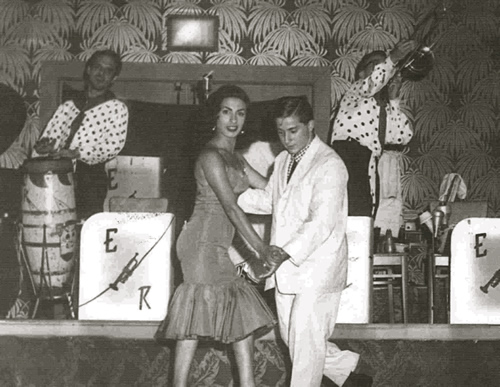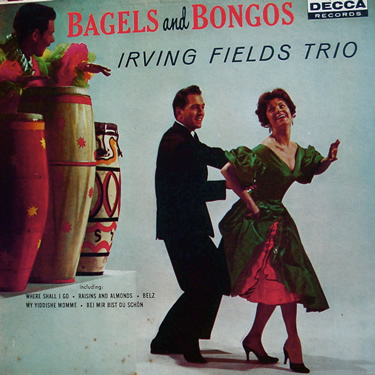Allegro
The Mamboniks
A true American story of the Jewish love affair with Latin music
Volume 113, No. 1January, 2013

A “mamboniks” couple dances to Emilio Reyes and his orchestra in the Catskills, where Jewish resorts featured Latin music in the 1950s and 1960s. Photo: Courtesy of the Catskills Institute
Sitting down in a Boston deli one day in 1959, Irving Fields faced a puzzling problem. A pianist and composer who loved Latin music, Fields had just finished recording a new album, and he needed a title. His record was an upbeat mix of Latin rhythms and Jewish melodies. As Irving took a bite of his bagel, the title finally hit him: “Bagels and Bongos.” His landmark record reportedly sold two million copies worldwide after its release.
Irving Fields and countless other Jewish musicians and dancers fell under the sway of Latin rhythms, and their love affair is chronicled in a new documentary film currently in production: “The Mamboniks.”
Their affinity for all sounds Latin began in the 1930s, when Jewish Americans got their first taste of the music while vacationing in Cuba. But their love blossomed on the dance floors of New York in the 1950s.
A new dance was on the rise: the mambo. At Manhattan’s Palladium Ballroom, known as “The Home of the Mambo,” Jewish dancers were captivated by the swinging big bands of Tito Puente, Machito and Tito Rodriguez. They became the mambo’s biggest non-Latino fans, earning them the nickname, “the mamboniks.”
“It’s a Yiddish expression,” Irv Greenbaum, a sound engineer for a variety of Latin record companies, once explained. “Whenever you add the suffix ‘nik to a word, it means follower or group member. Like beatnik. So a mambonik was someone who went crazy for the mambo. They danced to it, and went everywhere mambo was played.”
The film’s director is Alexis Gillespie, a veteran public radio producer and television writer. He is a three-time Peabody Award winner for two radio series he wrote and produced about culture and music: “Whole Lotta Shakin’,” a 10-hour exploration of rockabilly music of the 1950s (2008) and “Let the Good Times Roll,” a 26-hour history of rhythm & blues music (2005). He was a producer at the Smithsonian Museum of American History on the documentary series “Black Radio: Telling It Like It Was,” which won a Peabody in 1998.
Set in New York City, the Catskills, Miami Beach and Havana, “The Mamboniks” features an infectious soundtrack with the Afro-Cuban music of Tito Puente, Celia Cruz and Mongo Santamaria.
The film celebrates the mambo era with quirky, animated, and often funny first-person accounts from dancers, musicians, singers, club owners, disc jockeys, talent agents, hoteliers and record company moguls. These colorful characters are in their 70s, 80s and 90s now, and they remember mambo’s heyday. Many possess the Yiddish gift of gab, spinning their tales with humor, heart and chutzpah.
The Jewish affinity for Latin music in the 1950s is a mostly untold story, and the film explore how Jews re-defined their identity by embracing Lain song and dance during this heady decade. Most of the film’s characters are Jewish, but also featured are Cuban and Puerto Rican musicians including Pete Terrace and Jose Curbelo.
The story takes us from Havana of the 1930s and 40s, where the mambo was born, to the neon-lit New York City of the ‘50s, when this energetic dance flourished at the legendary Palladium Ballroom. We travel the mambo circuit, from the Catskills, where every Jewish resort hired top Latin bands, to the entertainment hotspot of Miami Beach. We also visit pre-Castro Havana of the late 50s, and hear how dancers performed as the bombs of Castro and his revolutionaries echoed in the streets.
The story chronicles the rise and fall of the mambo itself – a Cuban-born dance set to a mix of African rhythms and European melodies. Blessed with a catchy beat, the mambo pirouetted to prominence in mid-50s America. It was prominently featured in mass media; it inspired pop hits like Dean Martin’s “Mambo Italiano,” and network TV programs like the Ed Sullivan Show spotlighted mamboniks like Augie & Margo as they danced up a storm coast-to-coast.
Most dancers say the mambo was pure fun, but their affinity for it often runs deeper than that. During the post-World War II era, dancing helped Jews banish, at least for a moment, the horrors of the Holocaust and find joy once again. As Holocaust survivor Charles Swietarski explains, “People who experienced the bitter years of the War, who were later liberated, and looked forward to a new life, enjoyed the beat of the Latin music.”
Producer Lex Gillespie is currently searching for archival photographs, home movies or other footage from the mambo era. He is also looking for photos of Local 802’s hiring hall at its previous location at the Roseland Ballroom. Finally, Gillespie is seeking photos or films of Latin bands or dancers performing at the Palladium Ballroom (which once stood at West 53rd Street and Broadway) as well as photos of musicians performing at resorts in the Catskills during the 1950s and early ‘60s. E-mail Lex Gillespie at LexGillespie@yahoo.com
This article was published in the January 2013 issue of Allegro, the magazine of the New York City musicians’ union (AFM Local 802). For more background, see www.Local802afm.org

